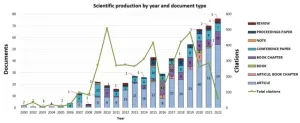(Press-News.org) BINGHAMTON, N.Y. -- When creating new materials for our modern needs, materials science engineers face a basic problem: Designing it to be strong when faced with loads in one direction may lead to structural weaknesses when facing stress from a different direction.
Binghamton University, State University of New York Assistant Professors Mir Jalil Razavi and Dehao Liu want to develop a solution using artificial intelligence and machine learning to suggest unique types of composite materials that meet specific mechanical behavior requirements.
“When we look at materials now, we usually tune mechanical properties in one direction,” Razavi said. “For example, they can absorb the shock in ‘x’ direction, but they don’t pay attention to what will happen to the ‘y’ or ‘z’ direction. While we strengthen in one direction, maybe we’ll compromise their mechanical properties in the other directions.”
A recent $313,087 grant from the National Science Foundation will fund the development of a deep-learning model informed by the principles of physical laws that can customize the microarchitecture of composite materials.
“Imagine trying to mix two types of materials,” Liu said. “One is very solid and stiff. One is very soft, like if you mix stone and gel and then glue them together. How can you design the distribution of the stone and the gel? They can show different mechanical properties at different directions.”
Razavi and Liu will develop thousands of mechanical computational models to train deep learning algorithms in designing composite materials tailored to specific needs. They will decide which suggestions are most promising, and their collaborator, Associate Professor Yanyu Chen from the University of Louisville (Kentucky), will validate the best combinations through additive manufacturing (3D printing), X-ray imaging and stress testing.
“With this research, the goal would be that you give the material properties you are seeking in that different direction, and I inversely fabricate the material for you,” Razavi said.
The idea for the project originated from Razavi’s research on the human brain. He hopes to chart the formation of brain folds as faster-growing grey matter (the outer layer where higher-level thinking is done) grows on top of white matter (the inner layer that communicates between different gray matter areas and between the gray matter and the rest of the body).
“Because brain tissue has different fiber tracts, it shows different mechanical properties in different directions,” he said. “When we want to fully characterize brain tissue, we need multiple loading cases to analyze that.”
The Binghamton team believes this machine learning research could revolutionize materials design and enable the rapid development of new materials with tailored properties for a wide range of applications, such as designing lighter structures, effective shock absorbers and aerospace components.
“It could be used not just in advanced areas like the brain, but also everyday materials like helmets and shoes,” Liu said. “If your shoes don’t feel comfortable, you can design your own personal pair using materials with different mechanical properties.”
END
Research to use machine learning to ’reverse-engineer’ new composite materials
Professors receive NSF grant for deep-learning model that can customize microarchitecture based on specific needs
2024-10-08
ELSE PRESS RELEASES FROM THIS DATE:
New research calls for transparency in Medicare Advantage operations
2024-10-08
New INFORMS Journal Manufacturing & Service Operations Management Study Key Takeaways:
As Medicare Advantage (MA) beneficiaries become sicker, health plans spend disproportionately less on their care relative to the payments received, with evidence suggesting this is partially due to illegal strategic cross-subsidization.
For each one-point increase in a patient’s risk score, their annual “spending-cost difference” (the gap between what MA plans spend on a patient vs. what they receive in payments) decreases by more than $9,000.
Strategic cross-subsidization could exacerbate socioeconomic inequalities in healthcare access and outcomes.
Rigorous oversight ...
Applied Biological Laboratories, maker of Biovanta, to present at American Society of Microbiology’s Clinical Virology Symposium 2024
2024-10-08
(New York, NY, Oct. 8, 2024) – New York City-based biotechnology company Applied Biological Laboratories has been selected to present research and data from a randomized, double-blind placebo-controlled clinical trial of Biovanta and research on pipeline products at the American Society for Microbiology (ASM) Clinical Virology Symposium in Long Beach, California on October 8, 2024. Applied Bio is part of NYU Biolabs, a collaborative research facility and biotech incubator affiliated with New York University’s Langone Medical Center. Biovanta is the company’s line of over ...
How academia drives sustainability: Discover the impact of science on the SDGs
2024-10-08
The role of universities in the fight for a fairer and more sustainable planet is increasingly significant. A team of researchers from ESPOL decided to examine how academia contributes to the Sustainable Development Goals (SDGs) by analyzing scientific publications on a global scale. Using tools such as ArcGIS, Biblioshiny, R, and VOSviewer, they conducted an in-depth review of scientific databases such as Web of Science and Scopus, tracking hundreds of articles addressing topics related to service-learning and community engagement. The results show a positive trend in scientific production on these topics, with a notable growth since 2009 and a peak in publications through 2022. ...
NOAA awards grant to enhance decision-ready climate projections for diverse stakeholders
2024-10-08
Researchers at the University of Miami Rosenstiel School of Marine, Atmospheric, and Earth Science were recently awarded $2.8 million of a $5.8 million grant from the National Oceanic and Atmospheric Administration (NOAA) Climate Program Office to support a groundbreaking four-year project aimed at developing best practices for decision-ready climate projection information. This work will address increased demand by public and private sectors for reliable, long-term extreme weather climate information.
This initiative, led by the Rosenstiel School and including partners from the National Center for Atmospheric Research, Colorado State University, and Florida International ...
Why using a brand nickname in marketing is not a good idea
2024-10-08
Researchers from Western University, Stockton University, and University of Massachusetts Amherst published a new Journal of Marketing article that examines if firms benefit from adopting popular nicknames in their branding efforts.
The study, forthcoming in the Journal of Marketing, is titled “BMW is Powerful, Beemer is Not: Nickname Branding Impairs Brand Performance” and is authored by Zhe Zhang, Ning Ye, and Matthew Thomson.
Many brands have popular nicknames that have become a part of ...
Asymmetric placebo effect in response to spicy food
2024-10-08
The expectations humans have of a pleasurable sensation asymmetrically shape neuronal responses and subjective experiences to hot sauce, according to a study published October 8th, in the open-access journal PLOS Biology by Yi Luo from East China Normal University, Kenneth Kishida from Wake Forest School of Medicine, U.S., and colleagues.
Expectations shape our perception, profoundly influencing how we interpret the world. Positive expectations about sensory stimuli can alleviate distress and reduce pain through what’s ...
Echoes in the brain: Why today’s workout could fuel next week’s bright idea
2024-10-08
In a rare, longitudinal study, researchers from Aalto University and the University of Oulu tracked one person’s brain and behavioral activity for five months using brain scans and data from wearable devices and smartphones.
‘We wanted to go beyond isolated events,’ says research leader Ana Triana. ‘Our behaviour and mental states are constantly shaped by our environment and experiences. Yet, we know little about the response of brain functional connectivity to environmental, physiological, and behavioral changes on different ...
Salk Institute’s Nicola Allen receives 2024 NIH Director’s Pioneer Award
2024-10-08
LA JOLLA (October 8, 2024)—The National Institutes of Health (NIH) has selected Salk Associate Professor Nicola Allen to receive a 2024 NIH Director’s Pioneer Award. The award recognizes exceptionally creative scientists pursuing highly innovative research and groundbreaking approaches to major challenges in biomedical, behavioral, or social sciences.
Allen will receive $3.5 million over five years to support her latest research, which investigates how plasticity in the adult brain could be enhanced. ...
The secret strength of our cell guards
2024-10-08
Proteins control most of the body’s functions, and their malfunction can have severe consequences, such as neurodegenerative diseases or cancer. Therefore, cells have mechanisms in place to control protein quality. In animal and human cells, chaperones of the Hsp70 class are at the heart of this control system, overseeing a wide array of biological processes. Yet, despite their crucial role, the precise molecular mechanism of Hsp70 chaperones has remained elusive for decades. Using a cutting-edge nanopore single-molecule technique, a team from the University of Geneva (UNIGE), in collaboration with EPFL, has now made a significant breakthrough in determining how Hsp70 chaperones ...
DataSeer and AAAS partner to boost reporting standards
2024-10-08
DataSeer and the American Association for the Advancement of Science (AAAS) are pleased to announce two new pilot programs designed to support high-quality reporting across scientific disciplines. The first will generate pre-filled MDAR reports for authors – saving them time and boosting the quality of methods reporting – for AAAS’ flagship journal Science. The second will establish an Open Science Indicators baseline dataset, quantifying how and when authors at Science share their ...
LAST 30 PRESS RELEASES:
Scientists boost cell "powerhouses" to burn more calories
Automatic label checking: The missing step in making reliable medical AI
Low daily alcohol intake linked to 50% heightened mouth cancer risk in India
American Meteorological Society announces Rick Spinrad as 2026 President-Elect
Biomass-based carbon capture spotlighted in newly released global climate webinar recording
Illuminating invisible nano pollutants: advanced bioimaging tracks the full journey of emerging nanoscale contaminants in living systems
How does age affect recovery from spinal cord injury?
Novel AI tool offers prognosis for patients with head and neck cancer
Fathers’ microplastic exposure tied to their children’s metabolic problems
Research validates laboratory model for studying high-grade serous ovarian cancer
SIR 2026 delivers transformative breakthroughs in minimally invasive medicine to improve patient care
Stem Cell Reports most downloaded papers of 2025 highlight the breadth and impact of stem cell research
Oxford-led study estimates NHS spends around 3% of its primary and secondary care budget on the health impacts of heat and cold in England
A researcher’s long quest leads to a smart composite breakthrough
Urban wild bees act as “microbial sensors” of city health.
New study finds where you live affects recovery after a hip fracture
Forecasting the impact of fully automated vehicle adoption on US road traffic injuries
Alcohol-related hospitalizations from 2016 to 2022
Semaglutide and hospitalizations in patients with obesity and established cardiovascular disease
Researchers ‘listen in’ to embryo-mother interactions during implantation using a culture system replicating the womb lining
How changing your diet could help save the world
How to make AI truly scalable and reliable for real-time traffic assignment?
Beyond fragmented markets: A new framework for efficient and stable ride-pooling
Can shape priors make road perception more reliable for autonomous driving?
AI tracks nearly 100 years of aging research, revealing key trends and gaps
Innovative techniques enable Italy’s first imaging of individual trapped atoms
KIER successfully develops Korea-made “calibration thermoelectric module” for measuring thermoelectric device performance
Diversifying US Midwest farming for stability and resilience
Emphasizing immigrants’ deservingness shifts attitudes
Japanese eels, climate change, and river temperature
[Press-News.org] Research to use machine learning to ’reverse-engineer’ new composite materialsProfessors receive NSF grant for deep-learning model that can customize microarchitecture based on specific needs





